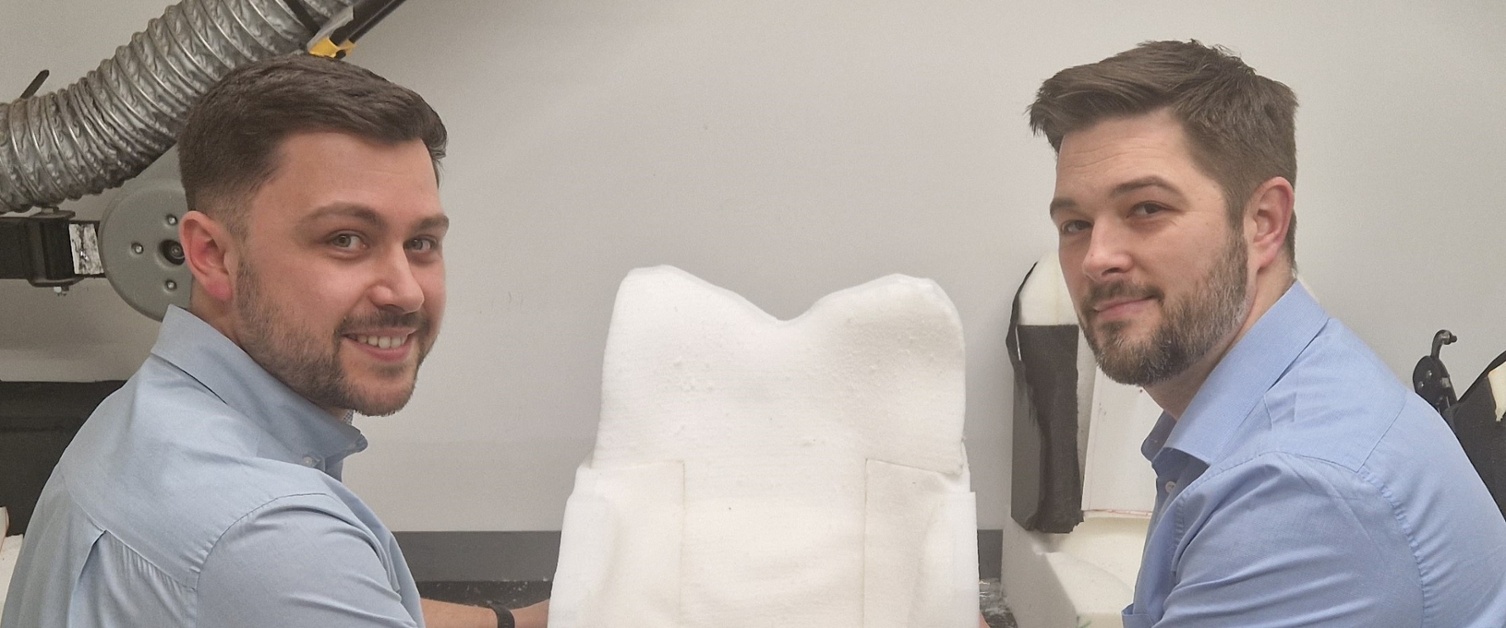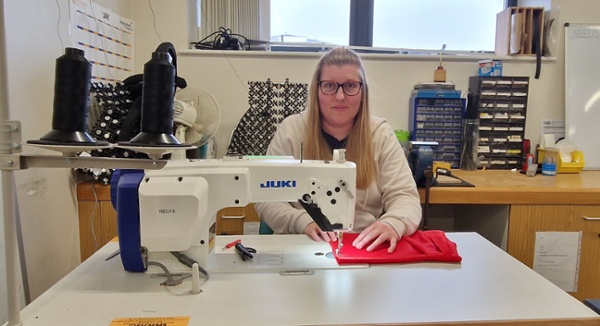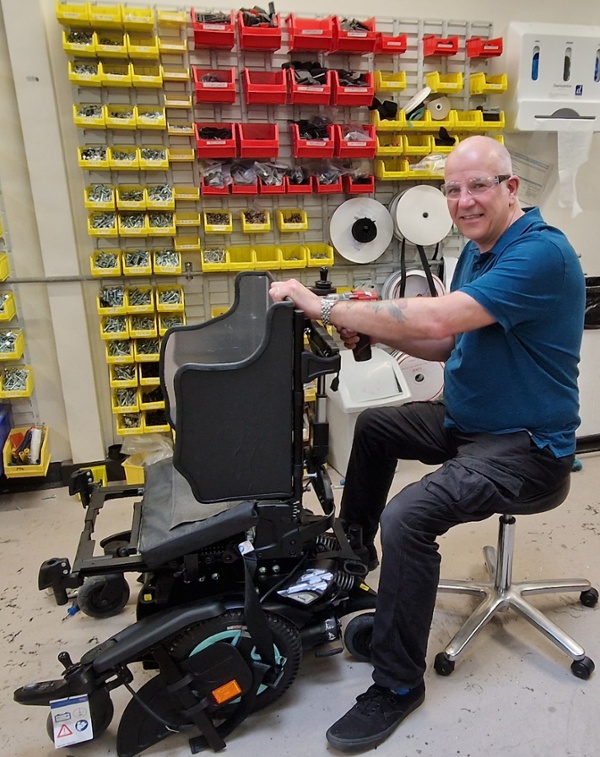Teamwork key to wheelchair workshop success

When it comes to teamwork, a skilled Swansea Bay team and their service users are sitting pretty – quite literally.
The Rehabilitation Engineering Unit (REU) workshop crew has won praise for its work, which includes creating special seating designed to offer wheelchair users the most comfortable ride possible.
Pictured above: Jacob Redwood-Thomas, Principal Clinical Scientist, and Jason Williams, rehab engineer.
Made up of rehabilitation engineers, technicians and upholstery technicians, the Morriston Hospital based team also designs, develops, and manufactures solutions for the health board’s Pressure Ulcer Prevention and Intervention Service (PUPIS).
The work of Jacob Redwood-Thomas, Jason Williams, Steffan Charles, Megan Thomas, Debra McCloy, and Kevin Haeney earned it a shortlisting for a Commitment to Research and Development Award in the 2023 Swansea Bay’s Living Our Values awards.
Benjamin Lee, Principal Clinical Scientist within REU, nominated the team.
He said: “The team has shown dedication to the research and development of new manufacturing techniques and material selection, which has resulted in innovative, safe, sustainable and cost-effective medical devices for service users.
“It’s a multidisciplinary team that combines scientific and engineering expertise to provide novel and bespoke solutions for our service users who cannot utilise standard equipment.
“Services include wheelchair special seating and PUPIS.
“The workshop is a unique and vital function for these services.”
Ben said post-Covid, there has been a 60% increase in bespoke contoured wheelchair seating systems which are manufactured in-house, requiring a greater level of workshop technician input.

Pictured above: upholstery technician, Debbie Mcloy
Looks are also important to the team.
Ben said: “The workshop has developed new innovative techniques to provide higher quality and more aesthetic pleasing solutions for our service users.
“For example, the introduction of aluminium shells for custom contoured seating are offering a stronger, lighter and aesthetically pleasing alternative to plastic.”
The new techniques have also reduced costs and place an importance on sustainable healthcare.
Ben said: “The biggest impact found is the recycling of foam offcuts; this is yielding a saving of £1,800 per annum.
“Unusable offcuts are now returned to the supplier and recycled reducing waste and the team’s carbon footprint. Other efforts include sourcing of materials with a lower carbon cost.”
The biggest winners, however, are the service users.
Ben said: “Ultimately, the work we do is for our service users, and it is clear to see that they are the heart of all the research and development that is taking place.
“The developments have provided greater patient choice and more attractive solutions, which in turn means a patient is more likely to be accepting of their wheelchair.”
And the best is yet to come.
“The workshop team have lofty ambitions that have only just started,” said Ben. “I am sure that they will continue to improve and develop processes and manufacturing techniques to produce improved custom-made medical devices for our service users.”
Jacob Redwood-Thomas, Principal Clinical Scientist, said: “People who are referred into the wheelchair service will be assessed for a wheelchair by a clinician.
“The NHS will purchase a wheelchair for that person, and if they require specialist or custom solutions, they can be referred on to us.
“The NHS purchase the wheelchair from the manufacturer, and we will make adaptations and modifications to better suit that wheelchair for the service user.
“Typically, we see service users with a range of diagnoses, including neurological/neuromuscular conditions such as cerebral palsy, muscular dystrophy etc., which can contribute to complex postures.
“It isn’t uncommon for standard off-the-shelf products to not meet their needs.
“That’s where we can help, by providing custom input.”
The team’s workshop has various machines to help carry out the modifications.
Jacob said: “We mainly manufacture custom moulded seating systems. To do this, we obtain or mould someone’s shape, using what is essentially a silicone bead bag.
“During the shape acquisition, the clinician can mould the shape either to improve or accommodate their posture based on the service users needs.
 Pictured left: technician Kevin Haeney
Pictured left: technician Kevin Haeney
“We then take a 3D scan of the moulded shape and then machine a foam replica that’s completely custom to their shape.
“Once we have machined the foam shape, we arrange a trial appointment to ensure the shape taken is suitable for the service user.
“Any slight modifications or trims to the foam can take place after the trial, prior to sending it to our in-house upholstery department. This is where we can manufacture the seat cushion covers and where our service users can pick things such as the colour of the covers to make it more personal to them.
“We also manufacture other solutions such as foot positioning aids, pressure relieving garments, bracketry to mount medical equipment to the wheelchair in case a service user requires a ventilator or oxygen cylinder to be with them when using their chair.”
The most rewarding part of the job is presenting the finished chair to the patient.
Jacob said: “It’s rewarding to be able to provide a bespoke solution to meet someone’s needs and make a real difference for them. There is a lot of job satisfaction in that.
“We’re very lucky to have the in-house facilities here to manufacture bespoke solutions for service users across south west Wales and we aim to make a positive difference to their lives.”
Rehabilitation engineer, Jason Williams, agrees.
He said: “Sometimes you can instantly see the relief on someone’s face just from making a small change.”
And upholstery technician, Debbie Mcloy, said: “We get some quite specific requests sometimes, which we need to work out solutions for so that’s really satisfying when we get it right.
“We’ve got quite a wide range of skills and make quite bespoke things for the service users.
“It’s great job satisfaction when you see something that you have made really make a difference to a patient.”
Rydym yn croesawu gohebiaeth a galwadau ffôn yn y Gymraeg neu'r Saesneg. Atebir gohebiaeth Gymraeg yn y Gymraeg, ac ni fydd hyn yn arwain at oedi. Mae’r dudalen hon ar gael yn Gymraeg drwy bwyso’r botwm ar y dde ar frig y dudalen.
We welcome correspondence and telephone calls in Welsh or English. Welsh language correspondence will be replied to in Welsh, and this will not lead to a delay. This page is available in Welsh by clicking ‘Cymraeg’ at the top right of this page.